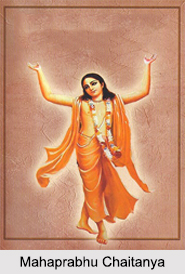 Gaudiya Vaishnavism is the branch of Vaishnavism, which was developed in Bengal. It was initiated by Mahaprabhu Chaitanya and it focused on the divine love relationship between Krishna and Radha. The philosophical basis of Gaudiya Vaishnavism is that of the Bhagavad Gita, Bhagavata Purana, Upanishads and other scriptures. This movement is also known as the "Brahma-Madhva-Gaudiya Sampradaya". It sees the many forms of Vishnu as incarnations of the one Supreme God, "Adipurusha". According to Gaudiya Vaishnavism consciousness is a symptom of the soul. All living beings are distinct from their current body. Souls which are obsessed by the Maya are reborn among the various species of life according to the laws of karma and individual desire.
Gaudiya Vaishnavism is the branch of Vaishnavism, which was developed in Bengal. It was initiated by Mahaprabhu Chaitanya and it focused on the divine love relationship between Krishna and Radha. The philosophical basis of Gaudiya Vaishnavism is that of the Bhagavad Gita, Bhagavata Purana, Upanishads and other scriptures. This movement is also known as the "Brahma-Madhva-Gaudiya Sampradaya". It sees the many forms of Vishnu as incarnations of the one Supreme God, "Adipurusha". According to Gaudiya Vaishnavism consciousness is a symptom of the soul. All living beings are distinct from their current body. Souls which are obsessed by the Maya are reborn among the various species of life according to the laws of karma and individual desire.
History of Gaudiya Vaishnavism
Mahaprabhu Chaitanya was born in the late 15th century in Nabadwip, West Bengal. During medieval period, Nabadwip was a part of the Gaud kingdom. As Vaishnavism was initiated by Chaitanya from this region, it was named as Gaudiya Vaishnavism. According to the initiation, Chaitanya belonged to the "Madhva" school of Vaishnavism, but his philosophical teachings were absolutely different from that of "Madhva". According to the scholars, before Chaitanya, Madhavendra Puri was a religious leader of the "Bhakti" movement in Bengal. Vaishnavism was initiated in Bengal by him. Iswar Puri, a disciple of Madhavendra, turned Chaitanya towards Vaishnavism. The doctrine of Chaitanya is called "Achintya- Bhedabhedavada", which has resemblance with the teachings of Nimbarka. He rejected the doctrine of "Maya" (illusion) and considered Krishna as the "Supreme God" and Radha as his energy.
Concept of Krishna Bhakti in Gaudiya Vaishnavism
Chaitanya considered the Krishna Bhakti as a total form of religion, which is above all other religious concept. Bhakti has been seen as the ultimate end; one should entirely dedicate himself to Krishna to attain liberation. Chaitanya taught his followers to chant the name of Krishna to surrender himself to God. He also described Bhakti as superior to jnana, which is also the effect of Bhakti. Through devotion one can get rid of all impurities and move towards the ultimate goal of Prema-Bhakti.
Concept of Vaishnava Sahajiya
In the post Chaitanya era, Vaishnavism in Bengal adopted a new concept, which was of the Sahajiya sect. In terms of theology, the Sahajiyas take the same path of Goswamis, but they differ in their religious practices. A follower of Sahajiya, believes that a man needs a woman as his companion other than his wife for his "Sadhana". They both consider themselves as Radha and Krishna. Hence, Sahajiya sect is often seen with prejudices by other religions and should be practiced in privacy. Vaishnava Sahajiyas are not vegetarians like other Vaishnavas.
Influence of Vaishnavism in Odisha
Vaishnavism also gave an intense influence in Odisha. During the medieval period, Vaishnavism in Odisha was associated with the worship of Jagannath only. Basically, Jagannath was worshipped by the local tribe "Savaras". Later on, Raja Indradyumna started worshipping Jagannatha, and the present Jagannatha temple was constructed in the mid-12th century A.D. It is said that Ramanuja"s visit to Puri made this region a center of Vaishnavism. Later, the arrival of Chaitanya added a new fervour to Vaishnavism in Puri. Chaitanya stayed there for about 18 years and influenced the religious life of people. He popularized the worship of Radha-Krishna in Odisha and visualized Lord Jagannatha as the incarnation of Lord Vishnu.




















